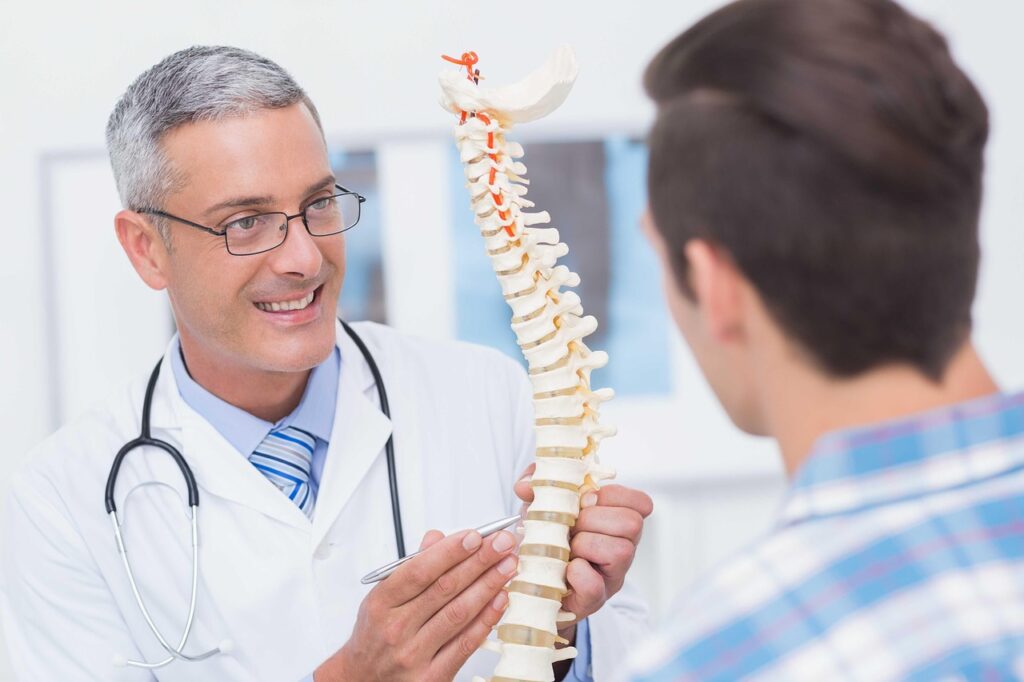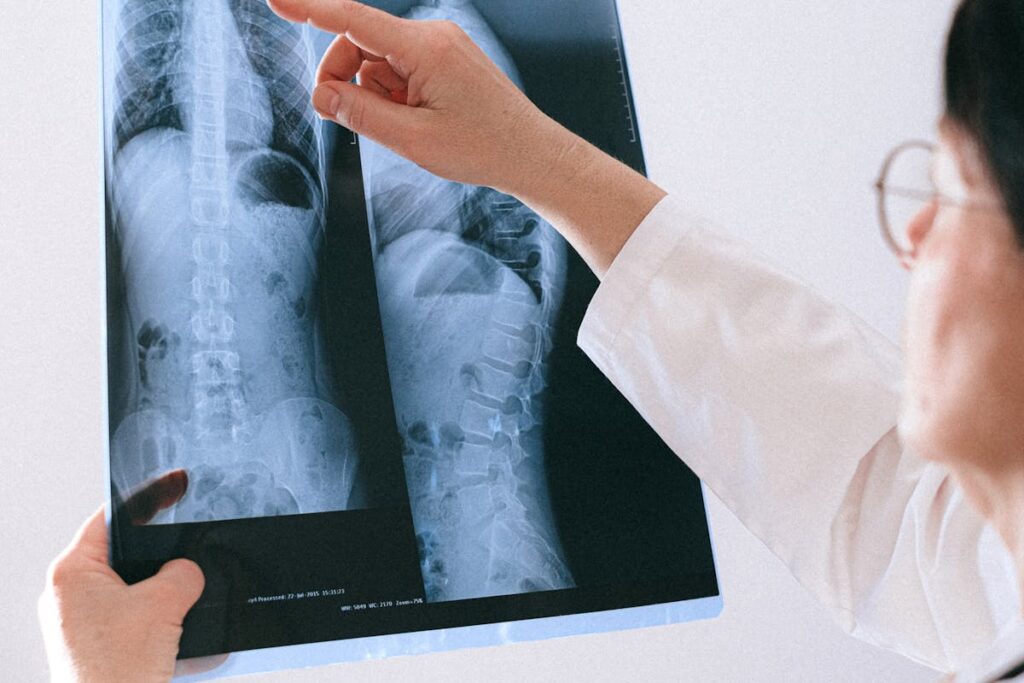As healthcare professionals, our understanding of lumbar stenosis – its diagnosis and subsequent management – has evolved considerably, with technological advancements dramatically improving our ability to detect and treat this condition. Through the lens of these developments, we explore the intricacies of early diagnosis, evaluation methodologies, and the multifaceted treatment strategies available. However, a question remains: how can we further refine our approach to guarantee the most efficient and effective management of lumbar stenosis? Join us as we investigate this critical conversation.
Understanding Lumbar Stenosis
Although it might seem intimidating, understanding lumbar stenosis is the first essential step in managing this condition. Lumbar stenosis refers to the narrowing of the spinal canal in the lumbar region, which comprises the five lowermost vertebrae of the spine. This area, critical to our lumbar anatomy, is particularly prone to degenerative changes that can lead to stenosis. There are two primary types of lumbar stenosis: central stenosis, involving the central spinal canal, and foraminal stenosis, where the nerve root canals narrow. Both types may cause compression of the spinal nerves or the spinal cord, leading to symptoms such as pain, numbness, or weakness. A thorough understanding of these stenosis types and the underlying lumbar anatomy is key to effective diagnosis and treatment planning.
Common Causes of Lumbar Stenosis
Lumbar stenosis is primarily instigated by a spectrum of factors, among which aging and genetic predisposition are paramount. The degenerative changes that accompany aging often contribute to a narrowing of the spinal canal, culminating in stenosis. Concurrently, a hereditary component may exacerbate the likelihood of developing this condition, necessitating an exploration into genetic factors that influence lumbar stenosis.
Aging and Lumbar Stenosis
As individuals advance in age, the risk of developing lumbar stenosis greatly increases. This is primarily due to age-related changes in the spine, which can result in spinal degeneration. This degeneration can lead to the narrowing of the spinal canal, a condition known as lumbar stenosis. The age-related changes often involve the intervertebral discs, which start to lose their water content, reducing their ability to act as shock absorbers and increasing the likelihood of disc herniation. Additionally, the ligaments of the spine may thicken and harden over time, further contributing to the narrowing process. The onset and progression of lumbar stenosis due to aging can vary considerably among individuals, depending on factors like lifestyle and overall health.
Genetic Factors in Stenosis
In addition to age-related factors, genetics also play an essential role in the development of lumbar stenosis. Research indicates a strong genetic predisposition towards the onset and progression of this condition. Certain hereditary factors can considerably increase the risk of developing lumbar stenosis. These include genetic mutations affecting the structure and function of the spine, such as those that cause abnormal bone growth or impinge on the spinal canal. Other inherited conditions, such as Ehlers-Danlos or Marfan syndrome, may also predispose individuals to lumbar stenosis. Understanding these genetic factors can aid in early detection and personalized treatment strategies, potentially improving patient outcomes. As a result, a thorough evaluation of a patient’s genetic background should be an integral part of the diagnostic process for lumbar stenosis.
Recognizing Lumbar Stenosis Symptoms
Recognizing the symptoms of lumbar stenosis is essential for timely intervention and effective management of the condition. This discussion will focus on the identification of characteristic signs, understanding the patterns of pain associated with lumbar stenosis, and how these manifestations correlate with physical activities. A thorough analysis of these aspects will aid in accurate diagnosis and the formulation of an appropriate treatment plan.
Identifying Lumbar Stenosis Signs
How can one discern the signs of lumbar stenosis? The clinical presentation often involves persistent lumbar pain, which varies in intensity and duration. This discomfort generally intensifies with activities such as walking or prolonged standing, which place additional stress on the lumbar spine. Neurologic symptoms, another vital identifier, are also common. These may manifest as numbness, weakness, or tingling in the lower extremities. In severe cases, patients may experience loss of balance or bowel and bladder dysfunction. However, the onset of these symptoms is typically gradual, and patients might not recognize them initially as signs of lumbar stenosis. Consequently, a detailed clinical examination is essential for accurate diagnosis.
Understanding Pain Patterns
While it may seem intimidating at first, understanding the pain patterns associated with lumbar stenosis can greatly aid in its early recognition and diagnosis. Pain triggers, or specific activities or positions that exacerbate discomfort, are often central to these patterns. Patients may experience variable pain intensities, frequently describing a sharp, stinging sensation or a dull, burning ache. Pain distribution is typically localized in the lower back, but can radiate to the legs as the condition progresses. Symptom relief often comes with rest or positional changes, indicating a direct link to spinal loading and movement. A careful understanding of these patterns can guide both patients and clinicians towards a more accurate diagnosis, enabling more effective treatment strategies for lumbar stenosis.
Correlation With Physical Activities
Despite the subtlety of early symptoms, lumbar stenosis often manifests itself through a clear correlation with physical activities. Patients typically report discomfort or pain during certain actions, particularly when standing or walking for extended periods. This discomfort may prompt them to seek frequent periods of rest, resulting in activity limitations. Exercise modifications become a significant part of managing the condition, helping patients maintain mobility while controlling symptoms. The nuanced understanding of this correlation is critical for healthcare providers to identify the presence of lumbar stenosis. It also assists in creating individualized interventions to minimize the impact of the condition on the patient’s lifestyle. Consequently, recognizing this correlation helps optimize patient management strategies and enhances the effectiveness of therapeutic interventions.

The Importance of Early Diagnosis
Recognizing the significance of early diagnosis in lumbar stenosis can greatly influence the prognosis and management of this medical condition. An early diagnosis facilitates timely assessment and evaluation of the patient’s condition, providing a window for early intervention. This is essential as it can slow the progression of the disease, alleviate symptoms, and improve the patient’s quality of life. It further allows for a more thorough management plan to be put in place, which is vital in the long-term care of the patient. Failure to diagnose this condition early can lead to irreversible neurological damage and disability. Consequently, the importance of early diagnosis in lumbar stenosis cannot be overstated, being a critical step in the effective management of this degenerative spinal disorder.
Diagnostic Procedures for Lumbar Stenosis
A multitude of diagnostic procedures are available for identifying lumbar stenosis, each with its own distinct advantages. Magnetic Resonance Imaging (MRI) is often the preferred method due to its non-invasive nature and ability to produce detailed images of the spinal structures, enabling precise identification of any narrowing or compression. MRI imaging can also reveal any co-existing pathologies, such as tumors or disc herniation, which may be contributing to the patient’s symptoms.
Electromyography tests provide further diagnostic value, evaluating the electrical activity in nerves and muscles. An abnormal result may indicate nerve compression due to lumbar stenosis. In combination, these diagnostic tools provide a thorough understanding of the patient’s condition, facilitating effective management strategies.
Overview of Treatment Options
Treatment options for lumbar stenosis range from conservative management to surgical interventions, depending on the severity of the condition and the patient’s overall health status. Conservative therapies primarily aim at pain management and include physical therapy, medications and epidural steroid injections. These methods can improve mobility, reduce inflammation and manage pain but may not halt the progression of the disease. When conservative therapies are ineffective, surgical interventions such as decompression surgery or spinal fusion may be necessary. These procedures aim at relieving pressure on the spinal cord or nerve roots, reducing pain, and improving function. The choice of treatment is individualized, based on patient’s symptoms, overall health, and personal preference after a thorough discussion of potential benefits and risks.
Living With Lumbar Stenosis: Management Strategies
Maneuvering daily life with lumbar stenosis requires effective management strategies to mitigate symptoms and maintain quality of life. Pain management is imperative, often involving a combination of pharmacological treatments and physical therapy. Non-steroidal anti-inflammatory drugs (NSAIDs) are commonly used to alleviate pain and reduce inflammation. Physical therapy, including targeted exercises and stretches, can help increase spinal mobility and strengthen supportive muscles. Concurrently, lifestyle modifications are significant. Ensuring a balanced diet, maintaining a healthy weight, and engaging in regular, low-impact exercises like swimming or walking, can help manage the condition. It is essential to avoid activities that exacerbate symptoms. A holistic, patient-centered approach combining pain management and lifestyle modifications can facilitate better living with lumbar stenosis.
Preventive Measures for Lumbar Stenosis
Implementing preventive measures for lumbar stenosis can markedly reduce the risk of developing this debilitating condition. Essential to prevention is the adoption of lifestyle modifications, such as maintaining a healthy weight to reduce strain on the lower back. Regular physical activity, particularly exercises that strengthen the core and improve flexibility, can also contribute to spinal health. Simultaneously, attention to good posture, whether sitting, standing or lifting, is critical to minimise undue pressure on the lumbar spine.
Physical therapy can play an integral role in prevention. Therapists can provide tailored exercise routines and educate individuals on proper body mechanics. Additionally, they can offer hands-on treatment to address early symptoms, potentially delaying or even preventing the progression of stenosis.
Frequently Asked Questions
What Is the Prognosis for Individuals With Lumbar Stenosis?
The prognosis for individuals with lumbar stenosis varies. It depends largely on the individual’s response to pain management strategies and surgical options. Some patients experience significant relief, while others may continue to have symptoms.
Can Lumbar Stenosis Lead to Complications if Left Untreated?
Yes, untreated lumbar stenosis can lead to complications such as chronic pain and mobility issues. Over time, the pain may become severe and persistent, greatly affecting the individual’s quality of life and functional abilities.
How Does Lumbar Stenosis Affect Daily Life and Physical Activity?
Lumbar stenosis can considerably impact daily life and physical activity due to persistent back pain. Pain management becomes essential, often necessitating lifestyle adjustments such as reduced physical activity and changes in sitting or standing postures.
Can Physical Therapy Help in Managing Lumbar Stenosis?
Yes, physical therapy can greatly aid in managing lumbar stenosis. Techniques such as targeted exercises and manual therapy have shown success in improving patient mobility, reducing pain, and enhancing the quality of daily life.
Are There Any Specific Dietary Recommendations for Patients With Lumbar Stenosis?
While there isn’t a specific diet for lumbar stenosis, consuming anti-inflammatory foods and certain nutritional supplements can support overall health. These include omega-3 fatty acids, turmeric, and vitamins D and B12.
